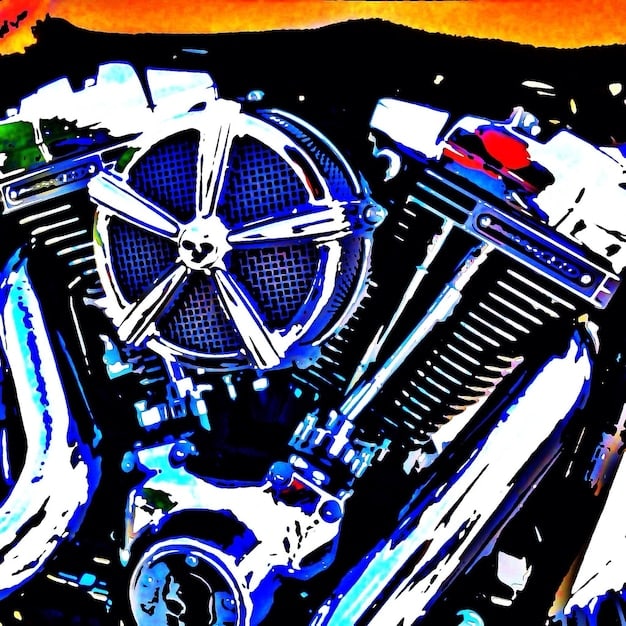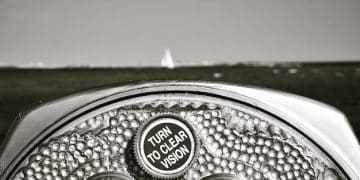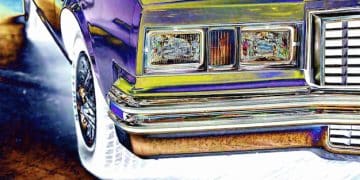The Art of Pinstriping: Techniques, History & Custom Car Detailing

The art of pinstriping involves applying thin lines of paint or vinyl to customize vehicles and other surfaces, blending historical techniques with modern practices to enhance aesthetics and showcase individuality.
Discover the intricate world of the art of pinstriping: a deep dive into the techniques and history of custom car detailing, where skilled artisans transform ordinary vehicles into personalized masterpieces with delicate lines and artistic flair.
Understanding the Origins and Evolution of Pinstriping
Pinstriping, a seemingly simple art form, has a rich and complex history deeply intertwined with the evolution of automotive culture and customization. From its functional origins to its modern artistic expressions, understanding this history is crucial for appreciating the craft.
Early Influences and Functional Roots
The earliest forms of pinstriping emerged long before automobiles. Carriage makers and sign painters used decorative lines to enhance the appearance of horse-drawn carriages and other vehicles. These lines served not only as decoration but also to visually separate and define different sections of the vehicle’s body, adding structure and refinement.
Pinstriping in the Automotive Era
As automobiles became more prevalent, the art of pinstriping transitioned from carriages to cars. Early automotive pinstriping often served a practical purpose, such as masking imperfections in body panels or highlighting the vehicle’s design. However, it quickly evolved into a form of artistic expression, with artists adding increasingly elaborate and intricate designs.
- The Rise of Hot Rod Culture: Pinstriping became an integral part of hot rod culture, allowing enthusiasts to customize and personalize their vehicles in unique and expressive ways.
- Influence of Custom Car Builders: Legendary custom car builders like Von Dutch helped transform pinstriping into a recognized art form, pushing the boundaries of creativity and technique.
- Modern Pinstriping: Today, pinstriping continues to thrive, with artists using both traditional and modern techniques to create stunning custom designs on cars, motorcycles, and other surfaces.
The evolution of pinstriping reflects the changing landscape of automotive design and culture. From its humble beginnings as a functional element to its current status as a respected art form, pinstriping remains a testament to the power of creativity and craftsmanship.
Essential Tools and Materials for Pinstriping
To embark on the pinstriping journey, it’s crucial to have the right tools and materials. These tools not only enable the creation of intricate designs but also influence the quality and longevity of the finished product. Selecting the appropriate equipment is a fundamental step in mastering this art form.
Pinstriping Brushes
The brush is arguably the most important tool in pinstriping. Different brush types offer varying levels of control and are suited for specific types of lines and designs. Common types include sword striper brushes, which are ideal for long, flowing lines, and lettering brushes, which provide greater precision for detailed work.
Paints and Preparation
Choosing the right paint is essential for achieving a professional look. Automotive-grade enamel paints are generally preferred due to their durability and vibrant colors. Proper surface preparation is also crucial; the surface must be clean, smooth, and free of any contaminants to ensure the paint adheres correctly.
- Brush Maintenance: Regular cleaning and proper storage are essential for maintaining the quality of pinstriping brushes, ensuring they remain in optimal condition for future projects.
- Paint Consistency: Achieving the right paint consistency is crucial for smooth and even lines, requiring careful mixing and thinning as needed.
- Surface Preparation: Thoroughly cleaning and preparing the surface ensures proper adhesion and a flawless finish, enhancing the overall appearance of the pinstriping.
Having the right tools and materials, coupled with a solid understanding of their proper use and maintenance, sets the foundation for successful pinstriping. These elements not only enhance the quality of the art but also ensure the artist’s ability to execute their creative vision with precision and skill.

Mastering Basic Pinstriping Techniques
Pinstriping, like any art form, requires a solid grasp of fundamental techniques. These techniques form the building blocks for more complex designs and are essential for achieving clean, consistent lines. Mastering these basics sets the stage for artistic expression and innovation.
The Importance of Hand and Body Positioning
Proper hand and body positioning are crucial for maintaining control and stability while pinstriping. Maintaining a relaxed posture and using the entire arm, rather than just the wrist, allows for smoother and more consistent lines. Practice is essential to develop muscle memory and achieve fluid strokes.
Line Control and Consistency
Achieving consistent line width and spacing is a hallmark of skilled pinstriping. This requires precise control over the brush and the amount of paint applied. Practicing different line weights and spacing variations hones the artist’s ability to create balanced and visually appealing designs.
- Consistent Practice: Regular practice sessions help develop muscle memory and refine the techniques needed for consistent and controlled pinstriping.
- Experimentation with Line Weights: Exploring different line weights adds depth and visual interest to the designs, enhancing their overall impact.
- Maintaining Steady Pressure: Applying consistent pressure on the brush ensures uniform paint flow, resulting in clean and professional-looking lines.
Mastering basic pinstriping techniques takes time, patience, and consistent practice. However, the ability to create clean, consistent lines is the foundation upon which all great pinstriping art is built. By focusing on these fundamentals, aspiring artists can develop the skills needed to bring their creative visions to life.
Advanced Pinstriping Styles and Designs
Once the foundational techniques are mastered, the world of pinstriping opens up to a myriad of advanced styles and designs. These advanced techniques allow artists to create more intricate and visually stunning pieces. Exploring these styles is where individual creativity truly shines.
Incorporating Scrolls and Flourishes
Scrolls and flourishes add elegance and sophistication to pinstriping designs. These elements require precise brush control and a keen eye for symmetry and balance. Mastering scrolls and flourishes elevates the overall aesthetic and adds a touch of artistry.
Modern and Geometric Patterns
Modern pinstriping often incorporates geometric patterns and abstract designs, offering a contemporary twist on the traditional art form. These patterns can range from simple shapes to complex tessellations, providing endless possibilities for creative expression.

- Studying Classic Designs: Analyzing classic pinstriping designs provides inspiration and insight into effective composition and technique.
- Experimenting with Color Combinations: Exploring different color combinations can dramatically alter the visual impact of the design, adding depth and personality.
- Blending Styles: Combining different pinstriping styles creates unique and innovative pieces, showcasing the artist’s versatility and creativity.
Advanced pinstriping styles and designs push the boundaries of traditional techniques, allowing artists to create truly unique and expressive works. By mastering these advanced techniques, pinstripers can transform ordinary surfaces into extraordinary works of art.
Pinstriping in Different Mediums and Applications
While pinstriping is most commonly associated with cars and motorcycles, its applications extend far beyond the automotive world. The versatility of this art form allows it to be applied to a wide range of mediums and surfaces, providing endless opportunities for customization and artistic expression.
Pinstriping on Motorcycles and Bicycles
Motorcycles and bicycles offer unique canvases for pinstriping, with their sleek lines and exposed frames. Pinstriping can be used to accentuate the curves of a motorcycle gas tank or add a touch of elegance to a bicycle frame. The possibilities are as diverse as the vehicles themselves.
Pinstriping on Home Décor and Accessories
Pinstriping can also be used to embellish home décor items and accessories, adding a personalized touch to everyday objects. From furniture to glassware, the possibilities for creative application are virtually limitless. This versatility makes pinstriping an attractive option for DIY enthusiasts and professional artists alike.
- Custom Furniture: Pinstriping adds a unique and personalized touch to furniture, transforming ordinary pieces into one-of-a-kind works of art.
- Home Accessories: Embellishing accessories like vases and picture frames with pinstriping brings a cohesive and artistic element to home décor.
- Mixed Media Art: Incorporating pinstriping into mixed media art projects creates depth and visual interest, showcasing the versatility of the technique.
The ability to apply pinstriping to various mediums allows artists to expand their creative horizons and reach new audiences. By exploring these diverse applications, pinstripers can continue to innovate and evolve the art form.
Caring for and Preserving Pinstriped Art
Once a pinstriping masterpiece is created, proper care and preservation are essential to ensure its longevity and maintain its visual appeal. Whether applied to a car, motorcycle, or other surface, protecting the artwork from the elements and everyday wear and tear is paramount.
Protecting Pinstriping from the Elements
Exposure to sunlight, rain, and other environmental factors can degrade pinstriping over time. Applying a clear coat or protective sealant helps shield the artwork from these elements, preserving its vibrancy and preventing fading or cracking. Regular cleaning and waxing also contribute to long-term protection.
Repairing and Touching Up Damaged Pinstriping
Despite best efforts, pinstriping may sometimes become damaged due to scratches, chips, or other mishaps. Minor damage can often be repaired with touch-up paint and careful reapplication of the affected lines. For more extensive damage, professional restoration may be necessary to restore the artwork to its original condition.
- Regular Cleaning: Gently cleaning the pinstriped surface with mild soap and water removes dirt and grime, preventing buildup that can damage the artwork.
- Applying Wax or Sealant: Applying a protective layer of wax or sealant helps shield the pinstriping from UV rays and environmental contaminants, extending its lifespan.
- Professional Restoration: For significant damage, seeking the expertise of a professional restorer ensures the artwork is repaired properly, preserving its integrity and value.
Taking the time to properly care for and preserve pinstriped art ensures that these beautiful creations can be enjoyed for years to come. By following these guidelines, enthusiasts and collectors can protect their investments and maintain the visual appeal of their pinstriped pieces.
| Key Element | Brief Description |
|---|---|
| 🎨 Origins of Pinstriping | Evolved from carriage decoration to automotive art. |
| 🖌️ Essential Tools | Includes brushes, automotive-grade paints, and proper surface prep. |
| ✍️ Basic Techniques | Line control, hand positioning, and consistent practice. |
| 🛡️ Preservation | Protect from sunlight and apply sealants for longevity. |
Frequently Asked Questions
What is the primary purpose of pinstriping on vehicles?
▼
The primary purpose of pinstriping is to enhance the aesthetic appeal of vehicles by adding decorative lines and custom designs, showcasing individuality and artistic flair.
What types of paints are best suited for pinstriping?
▼
Automotive-grade enamel paints are generally preferred for pinstriping due to their durability, vibrant colors, and resistance to environmental factors.
How can I maintain the quality of my pinstriping brushes?
▼
Regular cleaning with appropriate solvents, careful shaping after cleaning, and proper storage in a brush keeper can help maintain the quality of pinstriping brushes.
What are some common advanced pinstriping styles?
▼
Common advanced pinstriping styles include incorporating scrolls and flourishes, modern geometric patterns, flames, and intricate lettering.
How can I protect pinstriping from fading or damage?
▼
Applying a clear coat or protective sealant, regularly cleaning the surface with mild soap and water, and avoiding prolonged exposure to direct sunlight can help protect pinstriping.
Conclusion
In summary, the art of pinstriping is a blend of history, technique, and artistic expression. From its functional origins to its modern-day applications, pinstriping continues to evolve and inspire. Whether you are an aspiring artist or simply an admirer of the craft, understanding the intricacies of pinstriping provides a deeper appreciation for this unique and timeless art form.
“`
Read more content





